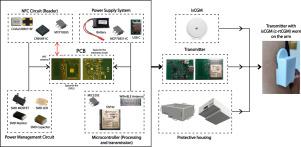Real-time converter of intermittent-scanned glucose sensors to continuous glucose monitors with potential future applications for insulin delivery
IF 2.1
Q3 ENGINEERING, ELECTRICAL & ELECTRONIC
引用次数: 0
Abstract
This paper presents the development of a transmitter that transforms intermittent glucose sensors (isCGM) into a continuous and real-time glucose monitoring system (c-rtCGM), a key component in automated insulin delivery systems. The transmitter enhances the capabilities of conventional intermittent sensors by leveraging Near Field Communication (NFC) technology to capture raw glucose value and automatically transmit it via Bluetooth Low Energy (BLE-Bluetooth 4.2 Dual-Mode) to a smart device every five minutes. A specialized glucose monitoring application converts the raw values to blood glucose by applying a calibration based on a static linear model and a capillary blood glucose measurement. The accuracy and performance of the c-rtCGM were validated through a study involving 37 participants with type 1 diabetes, demonstrating its reliability compared to commercial transmitters. Values reported by the c-rtCGM system compared with the isCGM monitor system resulted in an overall mean average relative difference (MARD) around 9%. During the trial, the c-rtCGM system achieved a data transmission success rate of 96%, and only 2316 connection failures were recorded from the 66525 total connection attempts, indicating a high level of communication stability. The transmitter battery life lasted an average of 6.5 days, showing that it is necessary to recharge only once for the duration of the sensor (14 days). The main advantages of this customized transmitter, in contrast with the commercial versions, are reliability, cost, and the flexibility of its software, since its processor (an ESP32) can be easily programmed to fulfill other helpful tasks in managing glucose levels with automated insulin delivery systems.

间歇扫描葡萄糖传感器到连续葡萄糖监测仪的实时转换器,具有潜在的未来应用于胰岛素输送
本文介绍了一种将间歇性葡萄糖传感器(isCGM)转换为连续和实时葡萄糖监测系统(c-rtCGM)的变送器的开发,该系统是自动化胰岛素输送系统的关键组成部分。发射器通过利用近场通信(NFC)技术来捕获原始葡萄糖值,并每五分钟通过低功耗蓝牙(BLE-Bluetooth 4.2双模式)自动将其传输到智能设备,从而增强了传统间歇性传感器的功能。一个专门的血糖监测应用程序通过应用基于静态线性模型和毛细管血糖测量的校准将原始值转换为血糖。通过一项涉及37名1型糖尿病患者的研究,验证了c-rtCGM的准确性和性能,证明了其与商业发射器相比的可靠性。c-rtCGM系统报告的数值与isCGM监测系统相比,总体平均相对差(MARD)约为9%。在试验期间,c-rtCGM系统实现了96%的数据传输成功率,在66525次总连接尝试中仅记录了2316次连接失败,表明通信稳定性很高。发射器的电池寿命平均为6.5天,这表明在传感器使用期间(14天)只需要充电一次。与商业版本相比,这种定制的变送器的主要优点是可靠性、成本和软件的灵活性,因为它的处理器(ESP32)可以很容易地编程来完成其他有用的任务,如通过自动胰岛素输送系统管理血糖水平。
本文章由计算机程序翻译,如有差异,请以英文原文为准。
求助全文
约1分钟内获得全文
求助全文
来源期刊

HardwareX
Engineering-Industrial and Manufacturing Engineering
CiteScore
4.10
自引率
18.20%
发文量
124
审稿时长
24 weeks
期刊介绍:
HardwareX is an open access journal established to promote free and open source designing, building and customizing of scientific infrastructure (hardware). HardwareX aims to recognize researchers for the time and effort in developing scientific infrastructure while providing end-users with sufficient information to replicate and validate the advances presented. HardwareX is open to input from all scientific, technological and medical disciplines. Scientific infrastructure will be interpreted in the broadest sense. Including hardware modifications to existing infrastructure, sensors and tools that perform measurements and other functions outside of the traditional lab setting (such as wearables, air/water quality sensors, and low cost alternatives to existing tools), and the creation of wholly new tools for either standard or novel laboratory tasks. Authors are encouraged to submit hardware developments that address all aspects of science, not only the final measurement, for example, enhancements in sample preparation and handling, user safety, and quality control. The use of distributed digital manufacturing strategies (e.g. 3-D printing) is encouraged. All designs must be submitted under an open hardware license.
 求助内容:
求助内容: 应助结果提醒方式:
应助结果提醒方式:


